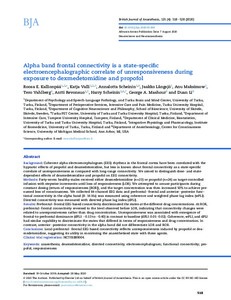Alpha band frontal connectivity is a state-specific electroencephalographic correlate of unresponsiveness during exposure to dexmedetomidine and propofol
Roosa E. Kallionpää; Katja Valli; Annalotta Scheinin; Jaakko Långsjö; Anu Maksimow; Tero Vahlberg; Antti Revonsuo; Harry Scheinin; George A. Mashour; Duan Li
Alpha band frontal connectivity is a state-specific electroencephalographic correlate of unresponsiveness during exposure to dexmedetomidine and propofol
Roosa E. Kallionpää
Katja Valli
Annalotta Scheinin
Jaakko Långsjö
Anu Maksimow
Tero Vahlberg
Antti Revonsuo
Harry Scheinin
George A. Mashour
Duan Li
ELSEVIER SCI LTD
Julkaisun pysyvä osoite on:
https://urn.fi/URN:NBN:fi-fe2021042821449
https://urn.fi/URN:NBN:fi-fe2021042821449
Tiivistelmä
Background: Coherent alpha electroencephalogram (EEG) rhythms in the frontal cortex have been correlated with the hypnotic effects of propofol and dexmedetomidine, but less is known about frontal connectivity as a state-specific correlate of unresponsiveness as compared with long-range connectivity. We aimed to distinguish dose- and state-dependent effects of dexmedetomidine and propofol on EEG connectivity.
Methods: Forty-seven healthy males received either dexmedetomidine (n=23) or propofol (n =24) as target-controlled infusion with stepwise increments until loss of responsiveness (LOR). We attempted to arouse participants during constant dosing (return of responsiveness [ROR]), and the target concentration was then increased 50% to achieve presumed loss of consciousness. We collected 64-channel EEG data and prefrontal-frontal and anterior-posterior functional connectivity in the alpha band (8-14 Hz) was measured using coherence and weighted phase lag index (wPLI). Directed connectivity was measured with directed phase lag index (dPLI).
Results: Prefrontal-frontal EEG-based connectivity discriminated the states at the different drug concentrations. At ROR, prefrontal-frontal connectivity reversed to the level observed before LOR, indicating that connectivity changes were related to unresponsiveness rather than drug concentration. Unresponsiveness was associated with emergence of frontal-to-prefrontal dominance (dPLI: -0.13 to -0.40) in contrast to baseline (dPLI: 0.01-0.02). Coherence, wPLI, and dPLI had similar capability to discriminate the states that differed in terms of responsiveness and drug concentration. In contrast, anterior-posterior connectivity in the alpha band did not differentiate LOR and ROR.
Conclusions: Local prefrontal-frontal EEG-based connectivity reflects unresponsiveness induced by propofol or dexmedetomidine, suggesting its utility in monitoring the anaesthetised state with these agents.
Clinical trial registration:NCT01889004
Kokoelmat
- Rinnakkaistallenteet [27094]
